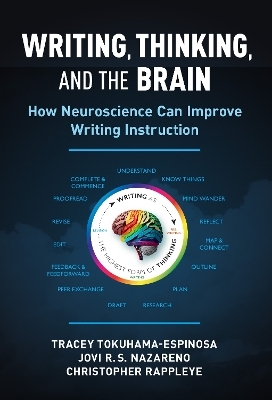
Writing, Thinking, and the Brain
How Neuroscience Can Improve Writing Instruction
Seiten
2024
Teachers' College Press (Verlag)
978-0-8077-8634-5 (ISBN)
Teachers' College Press (Verlag)
978-0-8077-8634-5 (ISBN)
- Noch nicht erschienen (ca. Dezember 2024)
- Versandkostenfrei
- Auch auf Rechnung
- Artikel merken
A one-of-kind resource constructed on the premise that everyone has the potential to be a great writer. This book will help teachers understand how the brain learns to write by unveiling 15 stages of thinking that underpin the writing process, along with targeted ways to stimulate them to maximize each individual’s writing potential.
Writing is the highest form of thinking, as evidenced by neuroimaging that shows how more neural networks are activated simultaneously during writing than during any other cognitive activity. This book will help teachers understand how the brain learns to write by unveiling 15 stages of thinking that underpin the writing process, along with targeted ways to stimulate them to maximize each individual’s writing potential. This one-of-a-kind resource is constructed on the premise that everyone has the potential to be a great writer. Many people learn to write in school settings according to a product-based structure in which they get feedback or a grade on an outline, draft, or final version of their work; few are coached on the many hours of thinking that go into that writing process. This book celebrates the invisible thinking behind the products, explains the brain’s way of making sense of writing assignments even in light of generative AI, and offers new tools to become a better writer and to assess the writing process. By exposing the invisible thinking behind the writing, Writing, Thinking, and the Brain helps both the teacher and the learner identify personal learning trajectories for better outcomes.
Book Features:
Spans all literary genres and all age groups and is complementary to any curriculum.
Builds on the firm foundation of writing practices of the past with insight from the learning sciences.
Practical and accessible examples and illustrations throughout.
Written in the voice of a supportive, knowledgeable colleague.
Linked directly to Mind, Brain, and Education goals.
Leverages Universal Design for Learning (UDL) principles.
Offers teacher activities at all 15 stages of thinking with guidelines to support student learning.
Writing is the highest form of thinking, as evidenced by neuroimaging that shows how more neural networks are activated simultaneously during writing than during any other cognitive activity. This book will help teachers understand how the brain learns to write by unveiling 15 stages of thinking that underpin the writing process, along with targeted ways to stimulate them to maximize each individual’s writing potential. This one-of-a-kind resource is constructed on the premise that everyone has the potential to be a great writer. Many people learn to write in school settings according to a product-based structure in which they get feedback or a grade on an outline, draft, or final version of their work; few are coached on the many hours of thinking that go into that writing process. This book celebrates the invisible thinking behind the products, explains the brain’s way of making sense of writing assignments even in light of generative AI, and offers new tools to become a better writer and to assess the writing process. By exposing the invisible thinking behind the writing, Writing, Thinking, and the Brain helps both the teacher and the learner identify personal learning trajectories for better outcomes.
Book Features:
Spans all literary genres and all age groups and is complementary to any curriculum.
Builds on the firm foundation of writing practices of the past with insight from the learning sciences.
Practical and accessible examples and illustrations throughout.
Written in the voice of a supportive, knowledgeable colleague.
Linked directly to Mind, Brain, and Education goals.
Leverages Universal Design for Learning (UDL) principles.
Offers teacher activities at all 15 stages of thinking with guidelines to support student learning.
Tracey Tokuhama-Espinosa, PhD, is an instructor at the Harvard University Extension School, and Harvard College Summer School, the associate editor of Nature Partner Journal Science of Learning, and an international educational consultant. Jovi R. S. Nazareno, MEd, is a graduate of Harvard’s Mind, Brain, and Education program, and is a learning science and education outreach specialist at MIT Open Learning. Christopher Rappleye, MFA, is the Ethan A. H. Shepley '41 Chair of Distinguished Teaching in English and Composition and a leader in social-emotional learning at the Mary Institute and Saint Louis Country Day School in St. Louis, MO.
| Erscheint lt. Verlag | 24.12.2024 |
|---|---|
| Verlagsort | New York |
| Sprache | englisch |
| Maße | 178 x 254 mm |
| Gewicht | 340 g |
| Themenwelt | Schulbuch / Wörterbuch ► Wörterbuch / Fremdsprachen |
| Geisteswissenschaften ► Psychologie ► Biopsychologie / Neurowissenschaften | |
| Geisteswissenschaften ► Sprach- / Literaturwissenschaft ► Literaturwissenschaft | |
| Geisteswissenschaften ► Sprach- / Literaturwissenschaft ► Sprachwissenschaft | |
| Sozialwissenschaften ► Pädagogik | |
| ISBN-10 | 0-8077-8634-9 / 0807786349 |
| ISBN-13 | 978-0-8077-8634-5 / 9780807786345 |
| Zustand | Neuware |
| Haben Sie eine Frage zum Produkt? |
Mehr entdecken
aus dem Bereich
aus dem Bereich
Grundlagen, Klinik, Rehabilitation
Buch | Softcover (2024)
Urban & Fischer in Elsevier (Verlag)
CHF 78,40
Buch | Spiralbindung (2022)
modernes lernen (Verlag)
CHF 41,90
Grundlagen, Klinik, Therapie und Verlauf der …
Buch | Softcover (2024)
Kohlhammer (Verlag)
CHF 117,60


